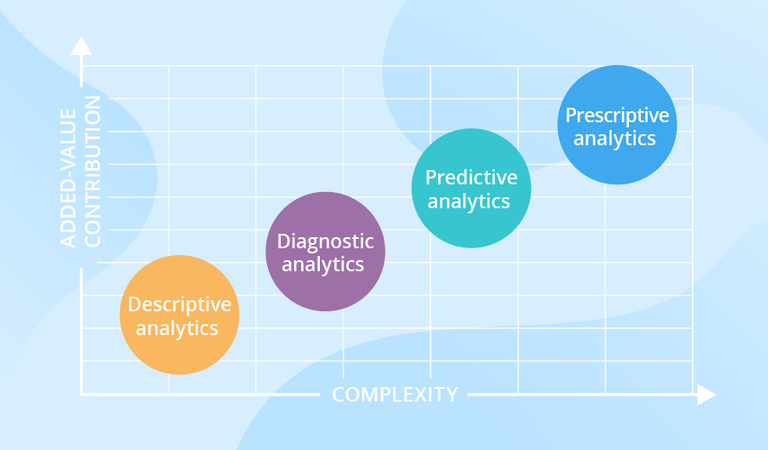A data scientist is a person who extracts useful information from the data and this person has some capabilities. Using these capabilities, data becomes meaningful. So how?
We can explain the process of extracting useful information from the data by considering some types of analytical approaches. Let's say we have a data set and let's take a look at this data with some approaches and see how useful information can be extracted from it.

In the image above, there are complexity and added-value contribution on two axes. Here are the approaches that address the process of extracting useful information from data on four different topics. Using this approach, it is transformed into a form that can turn data into action, extract information from itself, and use it for the benefit of businesses and the industry. This can sometimes be developing a product, sometimes creating a report, sometimes just visualizing data, sometimes doing simple Excel operations. Let's examine these types closely.
Descriptive Analytics
It looks for an answer to the question of what happened. In other words, when a data set comes to you, when you describe the data set, for example, when you analyze the data in the databases of the company in an analytical way, it is a way of explaining the situations such as which sales, how many sales, and in which category products were sold. So, the analytical type that we seek answers to the question of what happened is called descriptive analytics.
Diagnostic Analytics
We answered the question of what happened in the previous step. We described the current situation. In many scenarios, describing the current situation provides important added value. In this step, it is examined why these things happen. Yes, it looks for an answer to the question of why happen. When the 12-month sales numbers of an example are analyzed, let's assume that we saw some sales increase in January, February, and March, and the sales in other months are at a normal level. Here we have described the three-month increase, okay. When we question this increase, we do diagnostic analytics and tamper with its causes. Okay, we have described the current situation, this is a nice outcome. I may then hire staff to sell more in January, February, and March. But I have to investigate why this happened. When we look at the situation in this way, we respond to diagnostic analytics.
Predictive Analytics
That model is then used on current data to predict what will happen next. This is an analytical type that has a special place and provides many benefits, such as making predictions about the future and making companies strategically a few steps ahead, controlling the performance of their employees, giving more rational goals, and optimizing their processes compared to other analytical types. So how can this happen? For example, we have a scenario in our hands to predict when parts of a device in a manufacturing process might fail. In this scenario, workplaces can develop such a system of measures by estimating when parts of the physical equipment they use to prevent disruption of business processes. Or, when businesses estimate that their corporate customers working with them will abandon themselves, they can perform many activities to keep these customers in their hands. Predicting that the customer will be abandoned and taking action becomes an important step at this point. Similarly, it meets the needs to make predictions about the future such as whether the aircraft will be delayed or how late my flight will be, what will happen tomorrow, and to answer the question of what will happen and make a strategic positioning accordingly.
Prescriptive Analytics
It uses statistical models and forecasting techniques to understand the future and answer: “What could happen? These are more advanced statistical modeling techniques in the context of causality. It is used very often in the field of econometrics. Causality interpretations are made in this analytical type and some precautions are taken. Let's go back to the customer example in the previous example. In this example, whatever you do is the result of the modeling that the customer does not leave you, is prescriptive analytics. We say that, when we look at the data and build a model, we reduce the abandonment possibilities of our customers, where we observe values in certain parameters in some way. Here, the data scientist can make decisions that turn into various actions with these techniques in order to prevent some events.
In this article, I briefly talked about what it means to extract useful information from the data and what methods can be done. I will continue my blog posts on data science topics. Stay tuned!